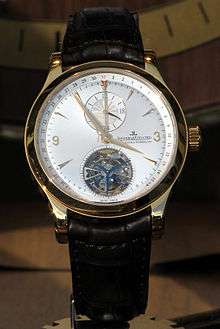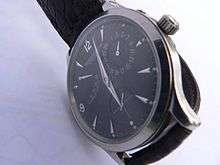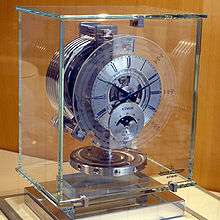Jaeger-LeCoultre
 | |
| Subsidiary of Richemont | |
| Industry | Watch manufacturing |
| Founded | 1833 by Antoine LeCoultre |
| Headquarters | Le Sentier, Vaud, Switzerland |
Key people | Daniel Riedo, CEO[1] |
| Products | Wrist watches |
| Parent | Richemont |
| Website |
jaeger-lecoultre |


Jaeger-LeCoultre (French pronunciation: ʒe'ʒɛʁ.lə'kultʁ)[2] is a Swiss luxury watch and clock manufacturer based in Le Sentier, Switzerland, that dates back to the first half of the nineteenth century, founded by Antoine LeCoultre in 1833.
The brand has hundreds of inventions and over a thousand calibres (movements) to its name, including the world’s smallest calibre, one of the world’s most complicated wristwatches and a timepiece of near-perpetual movement. The company has been a fully owned subsidiary of the Swiss luxury group Richemont[3] since 2000.
History
The LeCoultre family
The earliest records of the LeCoultre family in Switzerland date from the 16th century, when Pierre LeCoultre (circa 1530 – circa 1600), a French Huguenot, fled to Geneva from Lisy-sur-Ourcq, France to escape religious persecution. In 1558, he obtained the status of “inhabitant” but left the following year to acquire a plot of land in the Vallée de Joux. Over time, a small community formed and in 1612, Pierre LeCoultre’s son built a church there, marking the founding of the village of Le Sentier where the company’s Manufacture is still based today.[4]
The Manufacture
In 1833, following his invention of a machine to cut watch pinions from steel,[5] Antoine LeCoultre (1803-1881) founded a small watchmaking workshop in Le Sentier, where he honed his horological skills to create high-quality timepieces.[6] In 1844, he invented the world's most precise measuring instrument at the time, the Millionomètre [see section 1.4.1], and in 1847 he created a keyless system to rewind and set watches [see section 1.4.2].[6] Four years later, he was awarded a gold medal for his work on timepiece precision and Mechanization at the first Universal Exhibition in London.[6]
In 1866, at a time when watchmaking skills were divided up among hundreds of small workshops,[7] Antoine and his son, Elie LeCoultre (1842-1917), established the Vallée de Joux’s first full-fledged manufacture, LeCoultre & Cie., pooling their employees’ expertise under one roof. Under this set-up, they developed in 1870 the first partially mechanised production processes for complicated movements.[8]
By the same year, the Manufacture employed 500 people and was known as the “Grande Maison of the Vallée de Joux”, and by 1900, it had created over 350 different calibres, of which 128 were equipped with chronograph functions and 99 with repeater mechanisms. From 1902 and for the next 30 years, LeCoultre & Cie. produced most of the movement blanks for Patek Philippe of Geneva.
Jaeger-LeCoultre
In 1903, Paris-based watchmaker to the French Navy, Edmond Jaeger, challenged Swiss manufacturers to develop and produce the ultra-thin movements that he had invented.[6]
Jacques-David LeCoultre, Antoine’s grandson who was responsible for production at LeCoultre & Cie., accepted the challenge, giving rise to a collection of ultra-thin pocket watches, including the thinnest in the world in 1907, equipped with the LeCoultre Calibre 145 [see section 1.4.4].[6] The same year, French jeweller Cartier, one of Jaeger’s clients, signed a contract with the Parisian watchmaker under which all Jaeger movements for a period of fifteen years would be exclusive to Cartier. The movements were produced by LeCoultre.[6] Edmond Jaeger also acquired the patent for the atmospherically driven clock Atmos from its inventor Jean-Léon Reutter and licensed it to LeCoultre from 1936 for France, and in 1937 for Switzerland.
The collaboration between Jaeger and LeCoultre led to the company being officially renamed Jaeger-LeCoultre in 1937. However, from 1932 to approximately 1985, due to the Smoot Hawley Tariff Act, watches were cased in locally produced cases in North America and sold under the name LeCoultre by the company Vacheron-LeCoultre, a subsidiary of Longines-Wittnauer, with slightly different case designs. After 1985, Jaeger-LeCoultre was adopted uniformly worldwide. According to factory records, the last movement to be used in an American LeCoultre watch was shipped out of Le Sentier in 1976.
Some collectors and misinformed dealers have made the erroneous claim that American LeCoultre is not associated with Jaeger-LeCoultre Switzerland. The confusion stems from the 1950s, when the North American distributor of LeCoultre watches was the Longines-Wittnauer Group, which was also responsible for the distribution of Vacheron Constantin timepieces. Collectors have confused this distribution channel with the manufacture of the watches. According to Jaeger-LeCoultre enthusiast Zaf Basha, the "Galaxy", an upmarket mysterious dial diamond watch, is a collaboration between Vacheron & Constantin and LeCoultre for the American market. It features “LeCoultre” on the front and “Vacheron & Constantin — LeCoultre” stamped on the case. The LeCoultre trademark expired in 1985 and was replaced by the Jaeger-LeCoultre trademark.[9]
Jaeger dashboard instruments
LeCoultre of Switzerland and Jaeger of France formed a company in England, Ed. Jaeger (London) Limited, in 1921 to make instruments for prestige car manufacturers. In 1927 Jaeger LeCoultre sold 75 per cent of the company to S Smith & Sons and in 1937 the company name was changed to British Jaeger Instruments Limited.[10]
Inventions
Since Jaeger-LeCoultre’s founding, the company has produced over 1,242 different calibres, registered approximately 400 patents and created hundreds of inventions.
Millionomètre
Invented by Antoine LeCoultre in 1844, the Millionomètre was the first instrument in history capable of measuring the micron, allowing for the precise manufacture of watch parts. The invention was never patented, as no such system existed in Switzerland at the time. However, its unique composition was kept a closely guarded secret, used by the company for more than fifty years. It was presented at the Universal Exhibition in Paris in 1900.[11]
Keyless watch
In 1847, Antoine invented a keyless watch,[11] the second simple and reliable winding and time-setting system to do without a key after Patek Philippe's version of 1845.[12] Instead, it relied on a small push-piece that activated a lever to change over from one function to another.[6] Again, the invention was not patented, allowing other watchmakers to quickly implement the system.[11]
LeCoultre Calibre 145
In 1907, the LeCoultre Calibre 145 set the record for the world’s thinnest movement at 1.38 mm thick, appearing in pocket watches that remain to this day the thinnest in their category.[11] From 1907 until the 1960s, the movement was produced in some 400 copies.[13]
Grandes complications
In 1866, for the first time in watchmaking history, LeCoultre & Cie. began to manufacture calibres with small complications in small series, and in 1891 combined the chronograph and minute repeater complications into a double complication calibre.[14]
This subsequently led in the mid-1890s to the production of grandes complications, or watches comprising at least three classic horological complications, such as a perpetual calendar, chronograph and minute repeater.[11]
In 2004, the Manufacture created the Gyrotourbillon I, its first grande complication wristwatch, featuring a tourbillon gravitating on two axes, along with a perpetual calendar with double retrograde indicators and a running equation of time.[11] In 2006, it released the Reverso grande complication à triptyque, the first watch in history to be equipped with three dials driven by a single movement,[15] and in 2009 the company produced one of the world's most complicated wristwatches, the Hybris Mechanica à Grande Sonnerie with 26 complications.[16]
Timepieces
Reverso
Its name inspired by the Latin “I turn around”, the Reverso was created in 1931 as a watch capable of surviving the hard knocks of a polo game: the case can be swivelled in its carrier to protect the watch glass. Considered a classic of Art Deco design, the Reverso is still manufactured today.[11]
Duoplan
In 1925, the LeCoultre Calibre 7BF Duoplan was created in an effort to bring together miniaturisation and precision. The fashion of the period was for small wristwatches, however small calibres often suffered from a loss of reliability. Created by Henri Rodanet, the technical director of Etablissements Ed. Jaeger, the Duoplan was built on two levels – hence its name – enabling it to maintain a large-size balance.[11]
The Duoplan was also one of the first gem-set steel watches and, in 1929, its glass was replaced with sapphire crystal, a first in watchmaking. The Duoplan was ensured by Lloyd's of London with a special after-sales service, and a damaged movement could be replaced in a few minutes, leading London-based store owner Tyme to display in its shop window: “You won’t have time to finish your cigarette before your watch is repaired”.[17]
Joaillerie 101
The Duoplan led to the creation in 1929 of the world’s still-smallest mechanical movement, the Calibre 101, whose 74 original parts (98 today) weighed a total of approximately one gram. The second family of watches equipped with the Calibre 101, Joaillerie 101 Étrier appeared in the 1930s. In 1953, Elizabeth II of England wore a Jaeger-LeCoultre Calibre 101 wristwatch for her coronation.[18]
Atmos

The Atmos Clock is a timepiece of near-perpetual movement needing no human intervention and almost no energy. Invented by Swiss engineer Jean-Léon Reutter in 1928 in Neuchâtel, the Atmos clock has been the Swiss government’s official gift for important guests since 1950. Patented in 1928, the first version – known today as the Atmos 1 – was marketed by La Compagnie Générale de Radiologie (CGR) in 1930.[19]
It derives energy from small Temperature and Atmospheric pressure changes in the environment, and can run for years without human intervention. Wound by a capsule filled with a mixture of temperature-sensitive gases, a 1 °C fluctuation is enough to store sufficient energy to supply the clock with two days' autonomy.[20] Its balance, suspended from a steel-alloy wire thinner than a hair, performs two vibrations per minute; its gearing requires no lubricant. The Atmos' gearing is known for its accuracy: the moon-phase model, for example, accumulates a one-day discrepancy only once every 3,821 years.[11]
The patents were subsequently purchased by Jaeger-LeCoultre in France 1936 and in Switzerland in 1937. The company then spent ten years perfecting the clock before beginning to manufacture it in its current technological form in 1946.[11] In 1988, the Kohler and Rekow design agency created a two-piece limited edition showcase for the clock and, in 2003, the Manufacture released the Atmos Mystérieuse, driven by the Jaeger-LeCoultre Calibre 583 and comprising 1,460 parts.[21]
Memovox
In 1950, the Manufacture released the Memovox (potmanteau of memoria and vox, “voice of memory”), a year after the model cricket was released by Vulcain. Its striking mechanism could be used as an alarm for waking up, appointments, timetables, etc. The first models were hand wound and equipped with the Jaeger-LeCoultre Calibre 489.[22]
In 1956, a Memovox featuring the Jaeger-LeCoultre Calibre 815 became the first self-winding alarm watch in history, while shortly thereafter the company marked its 125th anniversary by releasing the Memovox Wordtime. In 1959, the Memovox Deep Sea was equipped with a specific alarm to remind divers to begin their ascension, and in 1965, the Memovox Polaris was released with a patented triple case back to optimise the transmission of sound under water.[11]
The latter model would go on to inspire the current Master Compressor and AMVOX lines. It was reproduced in 2008 under the name Memovox Tribute to Polaris.[23]
Futurematic
In 1951, the Manufacture released the Futurematic, the world's first 100% automatic watch, the calibre 497, Calibre 497 debuted with the Jaeger-LeCoultre Futurematic and was much more advanced than the earlier JLC 476 and JLC 481. It features a larger balance for improved accuracy and hacking seconds. One unique feature is a lock that holds the swinging weight in place when the mainspring is fully wound. It also features a special 6 hour power reserve, allowing the watch to immediately function when it is put on, rather than requiring it to be wound first.
The Calibre 497 featured a power reserve indicator along with small seconds located at the unusual position of 3:00.
Calibre 817 was used in the Jaeger-LeCoultre Futurematic and was a modification of the existing Calibre 497. Like that movement, it has a power reserve indicator at 9:00 and small seconds 3:00, but in Cal. 817 and Cal. 837 these are tiny round windows rather than being full subdials. Calibre 827 returned to the full subdial format,
Calibres 817, 827, and 837 were produced from 1956 through 1958, with just 3,500 movements made. About 3,000 of Cal. 817, 1,000 of Cal. 827, and just 500 of Cal. 837 were made.
Approximately 52,500 examples of Calibre 497 were produced between 1951 and 1958.
It has been said that the whole project for the Futurematic almost made the company bankrupt, as they never fully recovered their investment from sales of the Futurematic series of watches.
Geophysic
In honour of the International Geophysical Year in 1958, Jaeger-LeCoultre created a watch protected against magnetic fields, water and shocks. The Geophysic chronometer was proposed by long-time employee Jules-César Savary as a watch intended for scientific bases in Antarctica. The watch was fitted with the Jaeger-LeCoultre Calibre 478BWS and featured seventeen jewels, a Breguet overcoil, a regulating spring on the balance-cock, a shock-absorber and a Glucydur balance. The year of its release, the Geophysic was offered to William R. Anderson, the captain of the Nautilus, the first American nuclear submarine to travel between the Pacific and Atlantic oceans via the North Pole.[11]
Grand Complication
JLC produces some complicated watches (Grand complication), e.g. the Master Gyrotourbillon 1 with a spherical Tourbillon.[6] The Duomètre Sphérotourbillon is equipped with a tourbillon adjustable to the nearest second; the Reverso Répétition Minutes à Rideau is equipped with a minute-repeater shutter as a third face covering one of its two dials; the Master Grande Tradition Grande Complication is equipped with a flying tourbillon that follows the rhythm of celestial phenomena and indicates sidereal time, and a minute repeater comprising cathedral gongs; the Hybris Mechanica à Grande Sonnerie is equipped with gongs capable of playing the entire Big Ben chime; the Reverso Gyrotourbillon 2 is equipped with a spherical tourbillon principle, a reversible case and a cylindrical balance; the Master Compressor Extreme LAB is oil-free; the Gyrotourbillon 1 is equipped with a tourbillon evolving in three dimensions to compensate for the effects of gravity in all positions.[11]
Partnerships
UNESCO
Jaeger-LeCoultre and the International Herald Tribune have joined forces with UNESCO’s World Heritage Centre in support of the World Heritage Marine Programme. The partnership provides funding and media exposure for one of the World Heritage Committee’s priority programmes, leading to the listing of new marine sites and protection measures for the 46 sites already listed. Each year, the programme as well as the sites are featured in print and online news articles by the International Herald Tribune, thus offering increased visibility to the partnership.[24]
The Responsible Jewellery Council (RJC)
In October 2011, the Responsible Jewellery Council announced that Jaeger-LeCoultre had obtained certification for its commitment to human rights and for meeting the ethical, social and environmental standards established by the RJC’s Member Certification system.[25]
Aston Martin
In 2004, Jaeger-LeCoultre teamed with Aston Martin to launch the Aston Martin Jaeger-LeCoultre gentleman’s watch - the AMVOX1. The design of the timepiece was inspired by a 70-year historical link between the two companies. The dashboard of the 1930s, 1.5-litre Aston Martin LM – a regular class winner in international motorsport – contained instruments created by Jaeger-LeCoultre.[26]
Valextra
In partnership with the Italian luxury leathergoods brand Valextra, Jaeger-LeCoultre began offering a two-tone version of its ladies’ Reverso watch in 2012.[27]
Jaeger-LeCoultre and Equestrianism
Jaeger-LeCoultre has held close ties with the equestrian sports community since 1931 and counts the Polo Club de Veytay as one of its partners.
References
- ↑ Jack, Valerie (10 July 2013). "Jaeger-LeCoultre appoints new CEO Daniel Riedo". Hautetime. Retrieved 4 October 2013.
- ↑
- ↑ History including Significant Investments and Divestments, retrieved 2013 Check date values in:
|access-date=(help) - ↑ Fabrice Gueroux, La Manufacture Jaeger-LeCoultre célèbre 175 ans de développement continu autour de l'atelier d'Antoine LeCoultre, retrieved 2013-04-26
- ↑ Business Destinations delves inside the painstaking precision behind fine Swiss watchmaking, retrieved 2011-03-15
- 1 2 3 4 5 6 7 8 The Manufacture's Book of Timepieces, Le Sentier, VD, CH: Jaeger-Lecoultre, 2007.
- ↑ 175 years of continuous development around Antoine LeCoultre’s original workshop, retrieved 2009-04-12
- ↑ New temporary exhibition in the Jaeger-LeCoultre Heritage Gallery, retrieved 2010-06-21
- ↑ Jaeger-LeCoultre: a guide for the collector, Basha, Zaf, 2008.
- ↑ John Glanville and William M Wolmuth, Clockmaking in England and Wales in the Twentieth Century: The Industrialised Manufacture of Domestic Clocks, Crowood Press 2015 ISBN 9781847978967
- 1 2 3 4 5 6 7 8 9 10 11 12 13 Jaeger-LeCoultre: La Grande Maison, Franco Cologni, Flammarion, 2006.
- ↑ Stacy Perman: A Grand Complication: The Race to Build the World's Most Legendary Watch. Simon and Schuster, 2013. p. 155. ISBN 9781439190104.
- ↑ Master Ultra Thin Jubilee, retrieved March 2013 Check date values in:
|access-date=(help) - ↑ Double complications
- ↑ History of the Jaeger-LeCoultre Reverso, 2012
- ↑ Jæger-LeCoultre Hybris Mechanica, Professional Watches, 2009-6.
- ↑ The Manufacture Jaeger-LeCoultre celebrates its 180th anniversary
- ↑ Ariel Adams, Reflecting on the Jaeger-LeCoultre calibre 101 movement – World’s smallest, retrieved 2010-07-16
- ↑ Wireless Sensor Networks: Architectures and Protocols, Callaway, Edgar H, US CRC Press, 2003.
- ↑ Jaeger-LeCoultre: a guide for the collector, Basha, Zaf, 2008.
- ↑ Atmos Mystérieuse
- ↑ Wake-up Caller: Jaeger-LeCoultre’s Master Memovox, retrieved 2012-11-01
- ↑ Jaeger-LeCoultre Memovox Tribute to Polaris
- ↑ Jaeger-LeCoultre
- ↑ http://www.diamondne.ws/2011/10/19/jaeger-lecoultre-certified-by-the-responsible-jewellery-council/ External link in
|title=(help) - ↑ Jaeger-LeCoultre
- ↑ Jaeger-Lecoultre- A Reverso for St-Valentine’s day, retrieved 2012-02-06
External links
| Wikimedia Commons has media related to Jaeger-LeCoultre. |
- Official website, Jæger-Le Coultre.
- Jæger-Le Coultre (MS WMV) (video), Webcreation industry.
- History of the Jaeger-LeCoultre Reverso, Time and Watches.
- Photograph of Edmond Jaeger and Antoine LeCoultre, Atmos Adam.
- The history and calibers pictures of Jaeger-Lecoultre, Tendance horlogerie.
- Richemont acquires Les Manufactures Horlogères SA and the outstanding 40 per cent of Manufacture Jaeger-LeCoultre SA, Richemont.